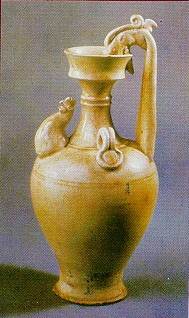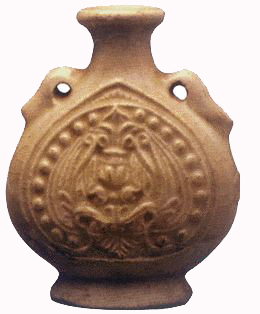 |
| Chicken-head pot |
The Sui Dynasty
(581-618) lasted for only 37 years -- from Yang Jian, known as Emperor Wendi who
set up the Sui Dynasty in 581 -- to Yang Guang, Emperor Yangdi, who was slain in
618. Being a typical, short-lived dynasty, the Sui enjoyed a significant
historical status because it had established many policies that were later
adopted by the Tang Dynasty (618-907). Furthermore, Emperor Gaozu of the Tang
Dynasty was a relative of Yang Guang, Sui Emperor Yangdi. Hence, to a certain
extent, the Tang Dynasty was an extension of the Sui and history books often use
the combination Sui-Tang to refer the two separate dynasties.
 |
| White-glazed two-eared flat
bottle |
Yang Jian, Sui Emperor Wendi, contributed a lot
to Chinese history during this period, namely the reform of official systems. He
abolished the six-officials system adopted by the Northern Zhou and replaced it
with three departments and six boards -- a system that was retained by the Tang
and acquired by Japan during the reform. The Sui Emperor also implemented the
system of imperial examinations to replace the Wei-Jin system, where local
officials were selected based on the recommendation of prefects. This system was
hailed as a great achievement that was more impartial and reasonable than the
previous ones, enabling more talented people to assume official
careers.
During the reign of Emperor Yangdi, the
Grand Canal was constructed -- a water transport artery that helped promote
economic development and unify the country. Despite his achievements, Emperor
Yangdi was also notorious for his cruelty: He killed all four of his brothers
and farther, Emperor Wendi, for the throne. Emperor Yangdi's cruelty aroused the
indignation of the masses. He was hanged in Jiangdu, which marked the end of the
Sui Dynasty.


